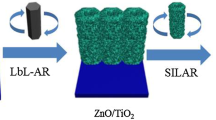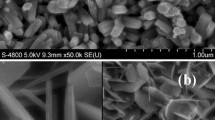Abstract
One-dimensional hollow hexagonal ZnO rods (1-D HHZRs) were grown onto the SnO2: F (FTO) coated glass substrates by using two-step deposition techniques. Initially, the ZnO seed layer was coated onto the FTO which was followed by hydrothermal route in order to grow 1-D HHZRs. These 1-D HHZRs were decorated with Eosin-Y dye and CdS semiconductor nanoparticles (NPs) by using a chemical routes like dip coating and successive ionic layer absorption reaction (SILAR) technique, respectively to improve its photoelectrochemical (PEC) performance. The structural, morphological, optical and electrochemical characterizations of the thin films were analyzed by various sophisticated instruments. X-ray diffraction (XRD) pattern corroborated the phase formation of ZnO and CdS with the hexagonal and cubic crystal structure, respectively. 1-D HHZRs films were obtained by scanning electron microscopy (SEM) with rod diameter of about 1.47 μm. Furthermore, SEM image clearly showed the CdS NPs covered 1-D HHZRs. The direct optical bandgap energy of the samples were estimated to be 3.28, 3.24 and 3.03 eV. CdS NPs-sensitized 1-D HHZRs samples showed hydrophilic nature for water contact angle, which is advantageous for the better improvement in the PEC performance as compared with pristine and dye-sensitized 1-D HHZRs.










Similar content being viewed by others
Change history
01 April 2019
Unfortunately, in the original publication of the article, the Fig.��7 has an oversight. On Y-axis current density is ���uA��� rather than ���mA���. The correct Figure is given below. The authors regret this error.
01 April 2019
Unfortunately, in the original publication of the article, the Fig.��7 has an oversight. On Y-axis current density is ���uA��� rather than ���mA���. The correct Figure is given below. The authors regret this error.
References
Dresselhaus MS, Thomas IL (2001) Alternative energy technologies. Nature 414(6861):332–337
Green MA (2007) Thin-film solar cells: review of materials, technologies and commercial status. J Mater Sci Mater Electron 18:15–19
Tarwal NL, Shinde VV, Kamble AS, Jadhav PR, Patil DS, Patil VB, Patil PS (2011) Photoluminescence and photoelectrochemical properties of nanocrystalline ZnO thin films synthesized by spray pyrolysis technique. Appl Surf Sci 257(24):10789–10794
Tarwal NL, Patil PS (2010) Superhydrophobic and transparent ZnO thin films synthesized by spray pyrolysis technique. Appl Surf Sci 256(24):7451–7456
Kong XY, Wang ZL (2003) Spontaneous polarization-induced nanohelixes, nanosprings, and nanorings of piezoelectric nanobelts. Nano Lett 3(12):1625–1631
Martinson ABF, Elam JW, Hupp JT, Pellin MJ (2007) ZnO nanotube based dye-sensitized solar cells. Nano Lett 7(8):2183–2187
Kamble A, Sinha B, Chung K, More A, Vanalakar S, Hong C, Kim J, Patil P (2015) Facile linker free growth of CdS nanoshell on 1-D ZnO: solar cell application. Electron Mater Lett 11(2):171–179
Rani S, Suri P, Shishodia PK, Mehra RM (2008) Synthesis of nanocrystalline ZnO powder via sol-gel route for dye-sensitized solar cells. Sol Energy Mater Sol Cells 92(12):1639–1645
Basyooni MA, Shaban M, El Sayed AM (2017) Enhanced gas sensing properties of spin-coated Na-doped ZnO nanostructured films. Sci Rep 7:1–12
Holmes J, Johnson K, Zhang B, Katz HE, Matthews JS (2012) Metal organic chemical vapor deposition of ZnO from β-ketoiminates. Appl Organomet Chem 26(6):267–272
Tarwal NL, Rajgure AV, Inamdar AI, Devan RS, Kim IY, Suryavanshi SS, Ma YR, Kim JH, Patil PS (2013) Growth of multifunctional ZnO thin films by spray pyrolysis technique. Sensors Actuators A Phys 199:67–73
Grätzel M (2003) Dye-sensitized solar cells. J Photochem Photobiol C Photochem Rev 4(2):145–153
Mali SS, Betty CA, Bhosale PN, Patil PS (2012) Eosin-Y and N3-dye sensitized solar cells (DSSCs) based on novel nanocoral TiO2: a comparative study. Electrochim Acta 59:113–120
Kamat PV (2008) Quantum dot solar cells. Semiconductor nanocrystals as light harvesters. J Phys Chem C 112:18737–18753
Mali SS, Desai SK, Dalavi DS, Betty CA, Bhosale PN, Patil PS (2011) CdS-sensitized TiO2 nanocorals: hydrothermal synthesis, characterization, application. Photochem Photobiol Sci 10(10):1652–1658
Tak Y, Hong SJ, Lee JS, Yong K (2009) Fabrication of ZnO/CdS core/shell nanowire arrays for efficient solar energy conversion. J Mater Chem 19(33):5945–5951
Zhai T, Li L, Ma Y, Liao M, Wang X, Fang X, Yao J, Bando Y, Golberg D (2011) One-dimensional inorganic nanostructures: synthesis, field-emission and photodetection. Chem Soc Rev 40(5):2986–3004
Mali SS, Kim H, Patil PS, Hong CK (2013) Chemically grown vertically aligned 1D ZnO nanorods with CdS coating for efficient quantum dot sensitized solar cells (QDSSC): a controlled synthesis route. Dalt Trans 42(48):16961–16967
Kamble AS, Sinha BB, Chung K, Gil MG, Burungale V, Park CJ, Kim JH, Patil PS (2014) Effect of hydroxide anion generating agents on growth and properties of ZnO nanorod arrays. Electrochim Acta 149:386–393
Cullity BD, Stock SR (2013) Elements of X-ray diffraction: Pearson new international edition, 3rd edn. Pearson Education Limited
Chandra S (1985) Photoelectrochemical solar cells. Gordon and Breach Science Publishers
Khot KV, Mali SS, Kharade RR, Mane RM, Patil PS, Hong CK, Kim JH, Heo J, Bhosale PN (2014) Novel-approach for fabrication of CdS thin films for photoelectrochemical solar cell application. J Mater Sci Mater Electron 25:5606–5617
Bhat TS, Mali SS, Sheikh AD, Korade SD, Pawar KK, Hong CK, Kim JH, Patil PS (2017) TiO2/PbS/ZnS heterostructure for panchromatic quantum dot sensitized solar cells synthesized by wet chemical route. Opt Mater (Amst) 73:781–792
Bhat TS, Devan RS, Mali SS, Kamble AS, Pawar SA, Kim IY, Ma YR, Hong CK, Kim JH, Patil PS (2014) Photoelectrochemically active surfactant free single step hydrothermal mediated titanium dioxide nanorods. J Mater Sci Mater Electron 25:4501–4511
Rajpure KY, Bhosale CH (2000) Study of substrate variation effects on the properties of n-Sb2S3 thin film/polyiodide/C photoelectrochemical solar cells. Mater Chem Phys 64(1):14–19
Shelke HD, Lokhande AC, Kim JH, Lokhande CD (2017) Photoelectrochemical (PEC) studies on Cu2SnS3 (CTS) thin films deposited by chemical bath deposition method. J Colloid Interface Sci 506:144–153
Baer WS (1967) Faraday rotation in ZnO: determination of the electron effective mass. Phys Rev 154(3):785–789
Acknowledgements
The authors PSP and SDK are very much thankful to the University Grants Commission (UGC), New Delhi, for the financial support through its project No. 43-517/2014(SR).
Author information
Authors and Affiliations
Corresponding authors
Rights and permissions
About this article
Cite this article
Patil, S.S., Tarwal, N.L., Yadav, H.M. et al. Photoelectrochemical performance of dye and semiconductor sensitization on 1-D hollow hexagonal ZnO rods: A comparative study. J Solid State Electrochem 22, 3015–3024 (2018). https://doi.org/10.1007/s10008-018-3995-y
Received:
Revised:
Accepted:
Published:
Issue Date:
DOI: https://doi.org/10.1007/s10008-018-3995-y




